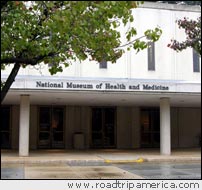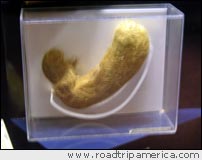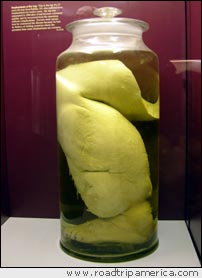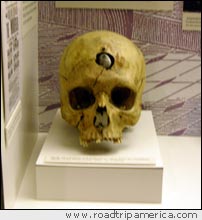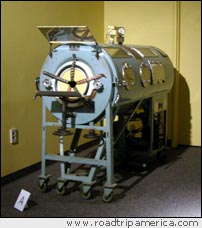|
On Beyond the Smithsonian:
THE NATIONAL MUSEUM OF HEALTH AND MEDICINE
I used to think that moon rocks were the most unusual thing I'd ever seen in a museum, but not any more. Even space nuggets don't come close to some of the exhibits at the National Museum of Health and Medicine in Washington, D.C. The NMHM may not be as well known as the treasure houses on Smithsonian row, but that doesn't mean it's any less memorable. This isn't the place to ogle the Hope Diamond or contemplate the Enola Gay, but some of the displays are equally haunting, and some are even more so.
I can't think of another museum, for example, that has a giant hairball in a glass case. A closer look reveals a couple of important things. First, the medical term for a hairball is "trichobezoar." Second, this impressive specimen developed in the stomach of a girl who'd eaten her own hair for nearly a decade. Hair, it seems, doesn't always move on through.
Exhibits like this might easily lead you to believe that the NMHM is a medically-inspired version of "Ripley's Believe It or Not." There's a big jar containing the leg of a man who suffered from elephantiasis, and a smaller one displaying a pair of full-term conjoined twins. While there's no denying that these relics are, in their way, educational, they also seem like things P.T. Barnum might have acquired to entertain suckers.
The NMHM, however, has no ties to the circus. It was founded back in 1862 to help teach military doctors how to deal with war wounds, and many of the exhibits reflect this early mission. One whole section is dedicated to displays of bones and skulls damaged by bullets and bayonets during the Civil War. More exhibits cover battlefield surgery and combat medicine from the Civil War to Viet Nam. A collection of microscopes illustrates their 400-year evolution, and a display about medical technology includes an iron lung, a shoe fluoroscope, and a vintage dental X-ray machine. Mixed in are an exhibit about venereal diseases and arsenic poisoning, complete with vividly frightening photographs and preserved body parts.
If this is not a museum for the squeamish, it is definitely a great destination for those tired of squeaky-clean political correctness. The curators of the NMHM unabashedly display human fetuses, deformed skeletons, and diseased genitalia, all glowing mysteriously under dim lighting designed to preserve them for posterity. As one visitor wrote in the guest book, "Gross! But I have to say, it held my attention."
For those who desire more than indelible memories, the NMHM has a gift shop that perfectly reflects the museum's unusual collections. Not only can you purchase postcards or a key chain decorated with a human heart, you can buy an opus about the medicine of war the size of the Encyclopedia Britannica.
I won't soon forget my pilgrimage to the National
Museum of Health and Medicine. In fact, I'm fairly certain it will linger
with me in perpetuity whether I want it to or not. This isn't a destination
for everyone, but for those who delight in history, medicine, and the
downright odd, it's an experience that won't disappoint.
Megan
Edwards
November 14, 2004
|
ONLINE RESOURCES |
||

